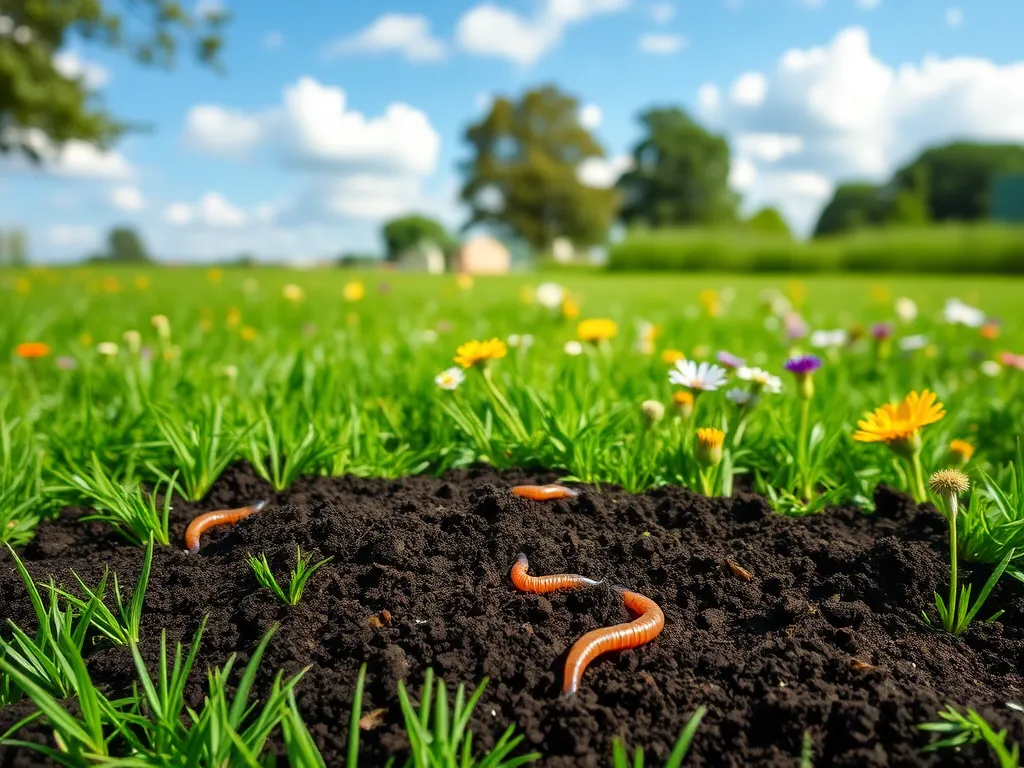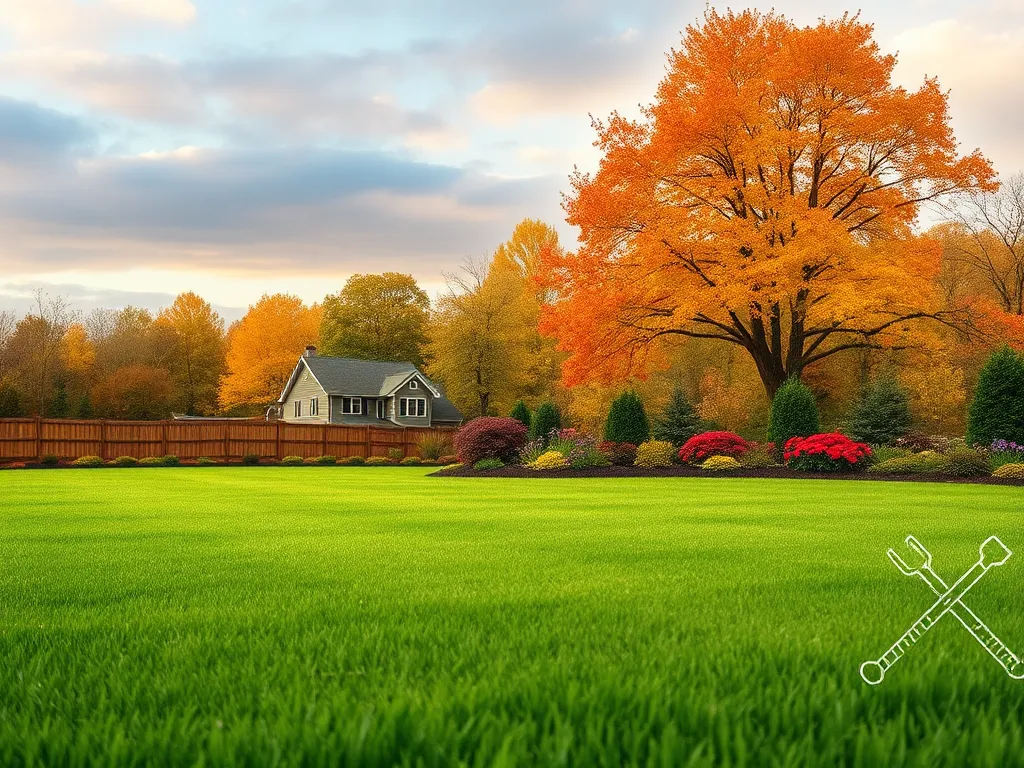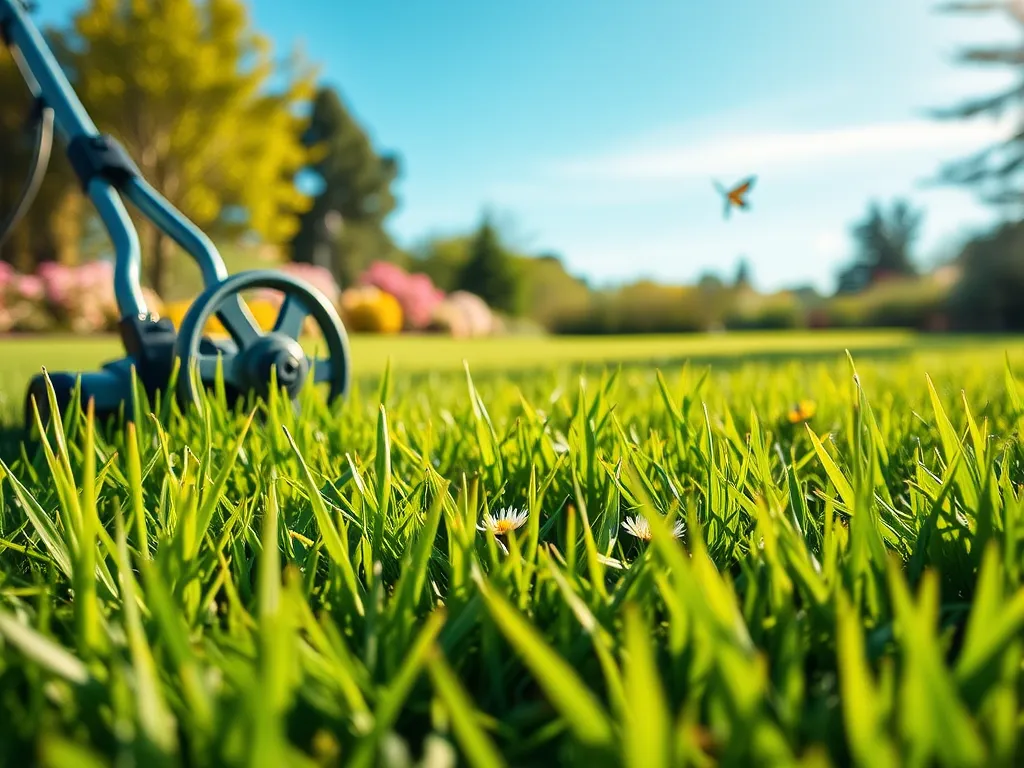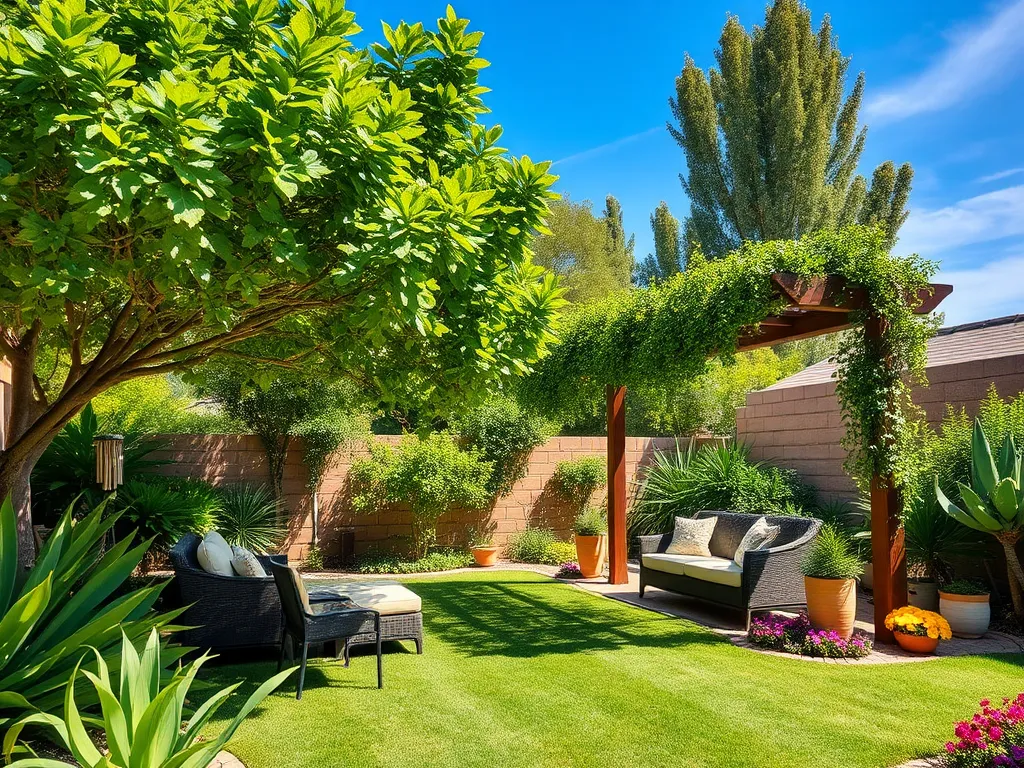
Simple and Effective Landscaping Ideas for Your Lawn Care Needs
Explore simple and effective landscaping ideas with Phoenix Pro Landscaping, featuring budget-friendly tips, lawn care essentials, and creative flower beds to enhance your yard. Discover how to use lawn care techniques, native plants, essential garden tools, and landscape lighting solutions for a sustainable and beautiful outdoor space.
Simple and Effective Landscaping Ideas
How to Incorporate Natural Elements?
Want a garden that fits in with nature? Start with native plants. They are perfect because they grow well in your local climate, use less water, and help local wildlife. Try adding rocks and water features like a small pond or stream to give your landscape texture and movement. Think about where to plant trees and shrubs for shade and structure. Ornamental grasses can make a nice border and add height. All of these elements help with eco-friendly landscaping by boosting biodiversity and saving water.
What Techniques Ensure Low Maintenance?
Do you want a garden that's easy to take care of? Use low-maintenance plants. Hardy grasses and perennial flowers are great choices since they need less attention and look good all year. Mulch is very helpful; it keeps the soil moist and cuts down on weeds. Look into xeriscaping, which uses drought-tolerant plants to lower water bills. For lawn alternatives, go with ground covers or clover, which require less mowing. Budget-friendly landscaping can still be beautiful!
Which Plants Work Best in Different Climates?
Picking the right plants for your climate is key. Because of climate change, choosing drought-resistant plants and succulents makes sense. Perennial garden ideas include plants that come back every year, giving lasting color without replanting. Use a plant selection guide to find out which shrubs and flowers will thrive in your area. The right plant choice leads to a healthy garden.
Creative DIY Garden Designs
How Can I Create Unique Pathways?
A garden path adds charm and function to your yard. Start with the construction of a garden path using pebbles and stones for a rustic look. Edging and borders define the path and keep materials in place. Line the path with mulch for a softer touch and a nice contrast with the stones. The right Phoenix Pro Landscaping can provide you with great garden design ideas.
Can I Use Recycled Materials?
Yes, you can! Using recycled materials saves money and is eco-friendly. Look for second-hand garden materials like old bricks or wood for pathway edging. You can also use gravel from other projects for new garden beds or paths. This approach is sustainable and helps reduce waste.
What Are Some Easy-to-Build Garden Structures?
Get creative with DIY garden design by making vertical garden structures. These are great for small spaces and can hold many plants. Building a birdhouse adds charm and attracts birds. Make a cozy patio with simple materials like gravel or reused wood. Container gardening techniques offer flexibility, letting you rearrange or update your garden easily. These ideas are budget-friendly and can turn your garden into a personal paradise.
Certainly! Here's the rewritten content following the given guidelines:
Budget-Friendly Landscaping Solutions
You don't need to spend a lot to transform your yard. With some simple planning and ideas, you can create stunning landscaping on a budget. Here are some cost-effective tips to get you started:
How to Minimize Costs?
- Shop for Second-Hand Garden Materials: Save money by looking for second-hand garden items like pots, tools, and plant cuttings. Check local garage sales, online marketplaces, or community swaps.
- Plan Before You Plant: Having a plan can help avoid expensive mistakes. Sketch your design and list supplies before starting your landscaping renovation. This will keep you focused and help avoid impulse buys.
What Are Some Affordable Plant Options?
- Low-Maintenance Plants: Pick plants that need little care, like succulents or ornamental grasses. These low-maintenance plants save time and reduce water use.
- Drought-Resistant Plants: Choose drought-resistant plants, such as lavender or sedum. They do well with less water, lowering your water bill while keeping your lawn lush even in dry times.
Tips for Finding Inexpensive Materials
- Mulch and Gravel: Find local suppliers offering discounts for buying mulch or gravel in bulk. They're great for improving your garden's look and keeping weeds away.
- Repurpose Materials: Be creative with what you already own. Use old bricks for pathways or repurpose concrete slabs into stepping stones for landscape lighting solutions.
Enhancing Curb Appeal on a Budget
Improve your home's first impression without spending much. Here are easy ways to boost your curb appeal:
What Small Changes Make a Big Impact?
- Creative Flower Beds: Add charm with colorful flower beds. Use affordable shrubs and perennials to create bright accents that refresh your front yard.
- Patio Upgrades: A few potted plants and trimmed grass can revamp your patio with little effort. It's an easy curb appeal tip that makes your outdoor space welcoming.
How to Use Lighting Effectively?
- Landscape Lighting Solutions: Use solar-powered lights along paths or spotlights to highlight decor. Modern landscape lighting can be inexpensive yet greatly enhance evening looks.
Which Quick Fixes Boost Appearance?
- Paint and Fencing: A fresh coat of paint on your front door or touch-ups on fencing can improve your home's look significantly. Minimalist garden styles with clean lines also give a polished appearance.
- Seasonal Decor: Change seasonal decorations to keep your yard looking fresh and in style. Small efforts in upkeep can lead to a big front yard makeover.
By using these tips, you can create an appealing outdoor space while keeping costs low. Share your landscaping stories or questions in the comments—we can learn from each other!
Sustainable Gardening Practices
Making your garden eco-friendly and beautiful is easier than you think. Here are some ways to practice sustainable gardening:
- Eco-Friendly Landscaping: Design your garden with nature in mind. Use natural materials, recycle items as planters, and avoid chemicals.
- Native Plants: Select plants that are local to your area. They need less water and care since they suit the climate and soil.
- Water-Efficient Landscaping: Save water by grouping similar plants together and using drip irrigation systems. Mulch helps keep the soil moist.
- Composting Basics: Turn kitchen scraps and yard waste into compost. This reduces waste and improves your soil's nutrients.
- Soil Health Improvement: Good soil is key for a healthy garden. Add organic matter like compost and use cover crops to enhance soil quality.
- Xeriscaping Methods: Use drought-resistant plants and efficient watering techniques, especially in dry areas.
- Pest-Resistant Plants: Choose plants that naturally keep pests away, which means fewer pesticides are needed. Herbs like basil and lavender help deter bugs.
These methods make your garden more sustainable and attractive.
Maximizing Small Outdoor Spaces
You can create a lovely outdoor space even with limited room. Here's how to make the most of small areas:
- Small Garden Ideas: Use mirrors to give a sense of more space and stick to a simple color palette.
- Outdoor Space Optimization: Use furniture that can serve multiple purposes. Foldable furniture can save space when not in use.
- Vertical Garden Structures: Install wall planters or use trellises for climbing plants to save floor space.
- Affordable Outdoor Furniture: Find budget-friendly and portable furniture. Consider DIY projects with pallets or old wood.
- Urban Balcony Gardens: Turn your balcony into a green space using pots and hanging planters. Choose plants that grow well in containers.
- Container Gardening Techniques: Use various container sizes for variety. Ensure good drainage and use suitable potting soil.
- Minimalist Garden Style: Keep designs simple with clean lines. Choose plants that are easy to maintain.
- Backyard Privacy Solutions: Use hedges, bamboo screens, or decorative panels for privacy. A small pergola can offer shade and seclusion.
These tips will help you turn small spaces into cozy and practical areas.
Seasonal Landscaping Tips
Maintaining a vibrant garden throughout the year requires understanding the impact of each season on your plants and landscape. Whether it's about seasonal garden upkeep or adapting to climate change, here are some straightforward tips to keep your garden thriving.
What Preparations Are Needed for Winter?
Winter can be tough on gardens, but with a few simple lawn care techniques, you can keep your space healthy:
- Mulch: Put down a layer of mulch to shield plant roots from frost.
- Snow Removal: Regularly clear snow from driveways and sidewalks to ensure safety.
- Gutters and Leaves: Clean leaves from gutters to prevent water overflow and damage.
- Frost Protection: Use frost covers or burlap to safeguard sensitive plants.
How to Transition Between Seasons?
Smoothly shifting your garden from one season to another keeps it attractive and healthy. Consider these actions:
- Planting: Select plants and shrubs suited for each season's conditions.
- Landscape Lighting: Adjust lighting for different daylight hours as seasons change.
- Pruning: Trim trees and shrubs to encourage strong growth.
- Yard Maintenance: Regular lawn and yard care keep your space tidy.
- Composting Basics: Start composting to naturally enrich your soil.
Which Plants Thrive Year-Round?
Choose plants that handle various weather conditions easily. Here are some recommended options:
- Native Plants: These need less maintenance as they're adapted to the local climate.
- Perennials: They come back every year with minimal effort.
- Evergreens: These provide color and structure even in the winter months.
- Drought-Resistant Plants: Ideal for areas with limited rainfall.
- Ornamental Grasses: These add texture and movement to your landscape.
Hardscaping Elements for Lasting Appeal
Adding hardscaping elements like patios and pathways enhances both the look and utility of your garden.
How to Integrate Stonework?
Stonework can make your landscape stand out. Here’s how to integrate it effectively:
- Masonry and Gravel: Use these materials for creating strong paths.
- Stone Pavers and Rock: Excellent choices for designing stylish patios.
- Pathways: Create walkways that guide visitors through your garden thoughtfully.
- Construction and Edging: Proper construction ensures durability and neat edges.
What Maintenance Do Patios Require?
Keeping your patio in great shape involves regular maintenance:
- Cleaning: Sweep and wash to remove dirt often.
- Sealing: Seal surfaces to protect them from weather damage.
- Repairs: Fix any cracks or damage right away.
- Drainage: Make sure water drains away from the patio to avoid pooling.
- Tools: Keep basic tools nearby for quick fixes.
How to Add Functional Walkways?
Make walkways that are useful and pleasant to walk on:
- Accessibility: Design wider paths for easy access.
- Layout: Plan the layout to link important areas in your yard.
- Materials: Use pea gravel or paving stones for durability.
- Design Strategies: Incorporate gentle curves for a natural look.
These tips will help keep your garden beautiful and functional all year long. By focusing on plant care and hardscaping, you can create a landscape that's not only appealing but also resilient to seasonal changes. Apply these tips to help your garden thrive!
Enhancing Your Yard with Artistic Features
Turn your yard into an artistic space that shows off modern landscape trends and your personal creativity. Here's how you can add art to your outdoor area:
- Landscape Lighting: Use lighting to highlight special parts of your garden. Try solar lights for paths or lanterns for your flower beds.
- Water Elements: Add a small fountain or pond to your yard. Water features add beauty and create a peaceful spot.
- Creative Flower Beds: Make your flower beds in fun shapes like spirals or squares. Ornamental grasses can give your beds different texture and height.
- Decorating with Sculptures: Place sculptures or artistic stakes in your garden. They showcase your style and can be the centerpiece of your yard.
- Optimizing Outdoor Spaces: Use every part of your yard. Create cozy seating areas with natural materials like bamboo or stone for a harmonious look.
By adding these elements, your yard will be both beautiful and useful.
Creating a Backyard Retreat
Your backyard can become a relaxing retreat. Here's how to design a space perfect for outdoor fun and rest:
- Outdoor Entertaining Spaces: Create areas with comfy seating and a table for guests. Choose affordable outdoor furniture made from sustainable materials to save money and help the environment.
- Patio and Plants: Surround your patio with shrubs and potted plants to create privacy and add greenery. Use drought-resistant plants for easy, water-efficient care.
- Sustainable Gardening Practices: Use practices like composting and planting native species for sustainability. These efforts reduce your environmental impact and help your garden thrive.
- Furniture Arrangement: Position furniture to form distinct areas—like dining and lounging zones—while leaving room to move around easily.
Creating a backyard retreat means designing a space where relaxation meets practicality. With these tips, your backyard can be a haven for both rest and socializing.
--- FAQs: ---
How can I create an effective and easy landscape design for my home?
To design a simple and effective landscape, start with basic landscape principles. Use low-maintenance plants such as groundcover to reduce work. Add rocks or pea gravel in walkways for texture and cost savings. A rock garden can also add interest. Make use of curves for a natural appearance.
What are some good ideas for adding shade to my garden?
Plant trees like spruce or pine to provide shade. For quick and cheap options, use fabric to create shaded spots. A shade garden with native plants is a good idea because they need less water and care.
How can I keep my garden pest-free naturally?
Use essential oils and straw mulch to keep pests away without chemicals. Pest-repelling flowers can help fight bugs, and having chickens can also assist in natural pest control.
What items are essential for beginner gardeners?
Beginner gardeners should get a good mower and basic gardening tools. Start with seeds and easy crops to learn about growth. Adding things like a birdbath or a fire pit can make your outdoor space nicer.
How can I make my garden more eco-friendly?
Use creative flower beds with native plants to save water. Artificial turf can also help conserve water. Heat pumps are good for efficient heating and cooling. Use eco-friendly ways instead of chemicals for snow removal.
What's the best way to deal with invasive species in my yard?
Regularly check for invasive species and remove them right away. Use selective weed killers that won't harm your other plants. Clear paths in your garden so you can easily monitor plant growth.
What materials can I use for a durable yet attractive walkway?
Use strong materials like pea gravel or rocks. They are stable and look nice in your garden. Adding practical features like a mailbox along the path can also be helpful.
Key Insights
- Design a basic landscape by using easy but effective methods to boost beauty and function.
- Look into easy landscaping ideas that can be done efficiently for homes.
- Make sure to have a good landscape design to get a successful outcome with little work.
- Add special items like pumpkins and gourds for a seasonal look in your landscaping idea.
- Think about edible landscaping ideas by adding food plants to your garden for a sustainable space.
- Follow tree planting tips for best growth, important in residential landscape planning.
- Use landscape design software to see and plan your outdoor space more easily.
- Keep up with seasonal garden upkeep to keep your landscape looking great all year.
- Solve slope problems with slope landscaping solutions for a stable, lovely garden.
- Boost biodiversity with bird-friendly features and use shade garden strategies for different settings.


Master Adjusting Cutting Height for Seasonal Changes

Discover the Benefits of Reel Mowers for Eco-Friendly Lawn Care

Mowing Frequency for Different Grass Types: A Complete Guide

